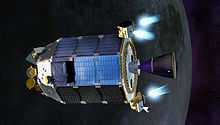2013 YP139
|
Near-Earth asteroid 2013 YP139—the six red dots in the composite image by NEOWISE specify the location of the asteroid. The inset is an enlargement of the image of December 29, 2013. | |
| Discovery[1] and designation | |
|---|---|
| Discovered by | NEOWISE |
| Discovery site | NEOWISE |
| Discovery date | December 29, 2013 |
| NEO, PHA | |
| Orbital characteristics[2] | |
| Epoch 2014-Jan-03.0 | |
| Aphelion | 3.55±0.24 AU |
| Perihelion | 0.76578±0.00033 AU |
| 2.16±0.14 AU | |
| Eccentricity | 0.645±0.024 |
| 3.17 years (1,160 d) | |
| 15.4±1.8° | |
| Inclination | 0.786±0.021° |
| 293.2±0.4° | |
| 82.137±0.72° | |
| Physical characteristics | |
| Dimensions | ~650 m (2,130 ft)[1] |
| 21.221±0.31136[2] | |
|
| |
2013 YP139 is a near-Earth asteroid discovered at a distance of 0.235 astronomical units from Earth.[2] by the Wide-field Infrared Survey Explorer. The asteroid is estimated to be 0.650 kilometers (0.404 miles) in diameter, 43 million kilometers (27 million miles) away, and is expected to come within 490,000 kilometers (300,000 miles) of Earth, though not within one hundred years of its discovery in 2013.[1] 2013 YP139 is the first asteroid to be discovered by the reinstated NEOWISE program of the Wide-field Infrared Survey Explorer, following the program's hibernation in 2011.[1]
Description
2013 YP139 is very dark, with an albedo comparable to a piece of coal. It orbits the Sun in an elliptical orbit along the invariable plane and is currently 42 million kilometers (27 million miles) away and is expected to come within 490,000 kilometers (300,000 miles) of Earth, slightly beyond the orbit of the Moon.[1] Due to this close proximity, NASA has classified 2013 YP139 as a potential threat. At the time of discovery, 2013 YP139 was moving at a rate of 3.2° per day (for comparison the apparent diameter of the Moon is 0.5°).[3]
Discovery
The Wide-field Infrared Survey Explorer's Near-Earth Object WISE (NEOWISE) program was put into hibernation on February 1, 2011, following several program extensions,[4] from which approximately 34,000 asteroids were detected.[1] On August 21, 2013, however, the program was reactivated.[4] The new mission of the NEOWISE was to identify the population of potentially hazardous near-Earth objects. 2013 YP139 was discovered on December 29, 2013, marking the first object detected since the program's reinstatement. The infrared brightness was the primary attribute used for ascertaining the approximate size of the asteroid. Over the course of half a day, the trajectory of the asteroid was observed against the stationary positioning of the stars in the background.[1]
The data from the Wide-field Infrared Survey Explorer was transmitted to the Infrared Processing and Analysis Center at the California Institute of Technology, located in Pasadena, California. To confirm the discovery, researchers at the University of Arizona utilized the Spacewatch telescope at the Kitt Peak National Observatory in Tucson, Arizona. 2013 YP139 is considered by NASA to be the first in what is expected to be thousands of objects to be detected by NEOWISE's new mission.[5] Due to the trajectory of the asteroid, which puts it within a potentially dangerous range in over one hundred years following its discovery, NASA stated that they would keep a watchful eye on it.[1]
See also
References
- ↑ 1.0 1.1 1.2 1.3 1.4 1.5 1.6 1.7 Agle, DC; Webster, Guy; Brown, Dwayne (January 7, 2014). "Recently Reactivated NASA Spacecraft Spots Its First New Asteroid". NASA.
- ↑ 2.0 2.1 2.2 "JPL Small-Body Database Browser (2013 YP139)". NASA. Retrieved January 7, 2014.
- ↑ "NEOWISE's New Find". NASA. January 7, 2014. Retrieved January 10, 2014.
- ↑ 4.0 4.1 "Wide-field Infrared Survey Explorer". Astro.ucla.edu. Retrieved January 10, 2014.
- ↑ "NEOWISE's New Find". Planetary Science Institute. Retrieved January 10, 2014.
External links
| ||||||||||||||||||||||||||||||||||||||
| |||||||||||||||||||||||||||||||||||||||||||

